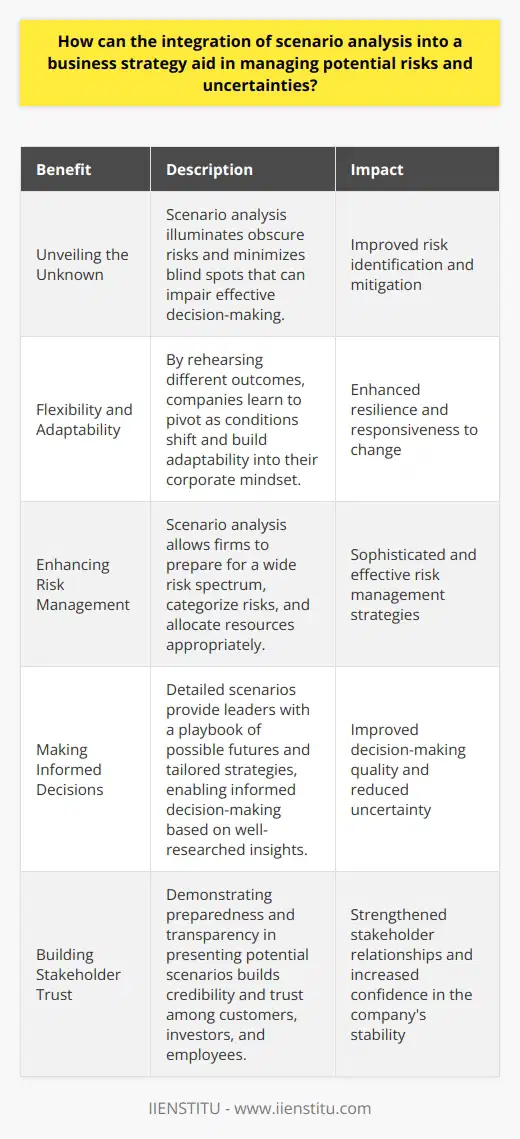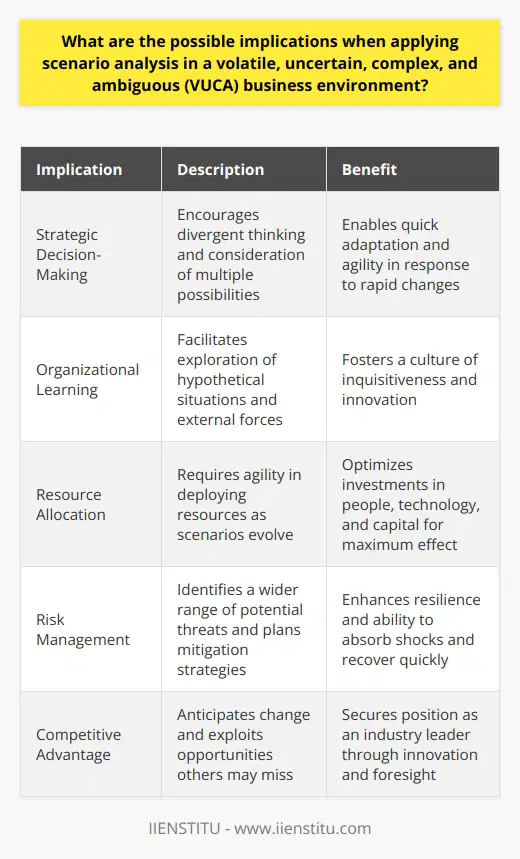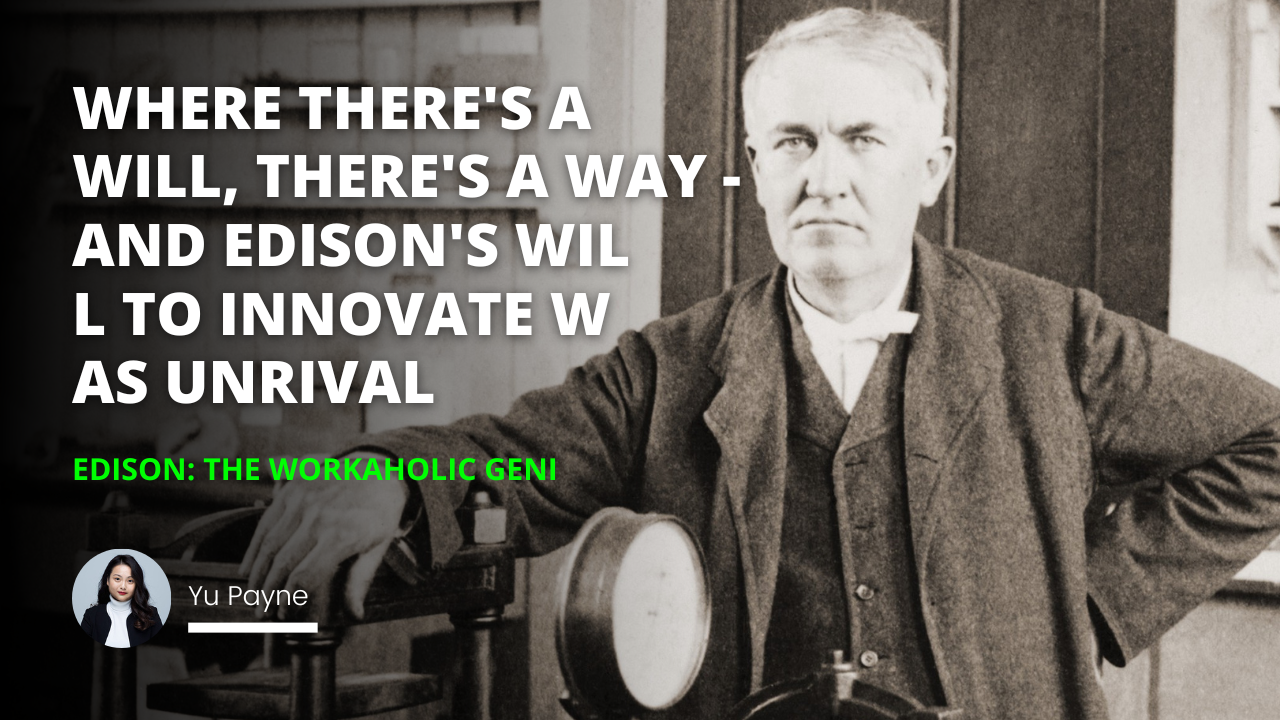
Scenario analysis stands as a sophisticated method of envisioning different possible futures by painting a variety of plausible scenarios, especially in the context of complex systems where uncertainty prevails. Its use can be especially pertinent to decision-makers—ranging from policy makers to business executives—who face the daunting task of navigating through ambiguity and change. By considering multiple potential developments in the environment, scenario analysis not only aids in strategic planning but also in risk management and forecasting.
The intricate methodologies of scenario analysis allow for a more robust approach to decision-making, aiding organizations in preparing for a myriad of possible realities.
Understanding Scenario Analysis
Definition of Scenario Analysis
Scenario analysis is a process of analyzing possible future events by considering alternative possible outcomes. This analytical tool is not about predicting the future; rather, it is about understanding the dynamics and variables that can lead to different future states. It involves identifying critical uncertainties and developing coherent and plausible narratives of the future, which can be used to test strategies and decisions against a set of diverse outcomes.
Origins and Historical Perspectives
The origins of scenario analysis can be traced back to military strategy and planning. During the Cold War, the RAND Corporation notably developed some of the earliest forms of scenario planning, with the goal of examining the potential outcomes of military and political conflicts. Since then, the application of scenario analysis has spread across various fields, evolving to accommodate business strategies and policy development, incorporating sophisticated models and algorithms to map out a wider range of possibilities.
Key elements of scenario analysis
Critical elements of scenario analysis include setting the scope of analysis, identifying primary drivers of change, mapping relationships between factors, and developing scenarios based on different combinations of future states of these drivers. These components work in a symbiotic manner to ensure a comprehensive understanding of the potential trajectories an entity might navigate through in the future.
Types of scenario analysis
There are several types of scenario analysis, each with specific uses. Some are exploratory, designed to explore what might happen, particularly useful in situations where there is high uncertainty. Others are normative, focusing on how specific targets or outcomes can be achieved. There's also quantitative scenario analysis, relying on numerical data and models, versus qualitative, which emphasizes narrative and storylines.
Scenario Analysis in Practice
Role of scenario analysis in strategic planning
Scenario analysis has increasingly become a keystone of strategic planning within corporations. It enables companies to envisage a variety of future business landscapes and to develop strategies that are resilient to different future events. By anticipating potential market shifts, technological advances, or socioeconomic changes, businesses can adopt a proactive approach to their strategic development.
Application of scenario analysis in risk management
Identifying and preparing for potential risks is a crucial aspect of maintaining organizational resilience. Scenario analysis serves as an invaluable tool in risk management by allowing entities to visualize the impact of various risk factors and to design mitigation strategies that can be implemented should those risks materialize. For instance, financial institutions may use scenario analysis to understand the potential impact of economic downturns on their portfolios.
Usage of scenario analysis in forecasting
Forecasting, while inherently uncertain, can be significantly enhanced by the application of scenario analysis. This form of analysis does not attempt to offer a single, accurate prediction of the future but instead provides a range of outcomes based on multiple possible scenarios. This methodology allows decision-makers to prepare for various future market conditions, customer behaviors, or global events.
Scenario analysis in the financial sector
Financial institutions leverage scenario analysis to navigate the complexities of the economic landscape. By constructing diverse economic scenarios based on variables such as interest rates, inflation, and currency fluctuations, these institutions can stress-test their investment portfolios or evaluate the robustness of their financial plans. Specific examples in the financial industry illustrate how scenario analysis can help in making nuanced and informed strategic decisions.
Strengths and Limitations of Scenario Analysis
Strengths of scenario analysis
Among the most significant strengths of scenario analysis are its capacity to highlight uncertaintiesto decision-makers, thus fostering flexibility in strategic thinking and planning. Furthermore, it broadens the horizon of planners, transcending conventional forecasting by illuminating unforeseen opportunities and threats, hence facilitating more innovative and resilient strategic approaches.
Limitations of scenario analysis
Despite its notable advantages, scenario analysis is not without limitations. The development of scenarios can be subjective, reliant on the creators' perspectives and insights, which may lead to overlooked possibilities. Moreover, the resource-intensive nature of creating and analyzing comprehensive scenarios can be a constraint for some organizations.
Balancing strengths and limitations
In practice, the value of scenario analysis often lies in the balance between its strengths and limitations. Decision-makers must recognize the subjectivity inherent in scenario construction and actively seek diverse inputs to mitigate it. They should consider scenario analysis as one component of a holistic decision-making framework, combining its insights with other strategic tools to build robust strategies.
In the realm of decision-making, scenario analysis emerges as a compelling tool offering insights that span beyond conventional prognostication. Its interdisciplinary application—from corporate strategy to public policy—underscores its importance in modern governance and business. The foresight imparted by scenario analysis empowers leaders to navigate potential challenges with greater confidence, making it an indispensable element in any forward-thinking entity's toolkit. Leaders and strategists are thus well-advised to embrace scenario analysis as part of their arsenal in carving out successful and sustainable paths for their organizations.
Frequently Asked Questions
What are the various steps involved in scenario analysis and how can they influence the decision-making process?
Understanding Scenario Analysis
Scenario analysis forms a core tool for strategic planning. It involves examining possible future events. This technique envisions distinct alternatives that reflect a variety of plausible conditions. It aims to assess the impact on decision-making. Decision-makers embrace this tool to plan for uncertainty. It helps gauge the robustness of strategies under different circumstances.
Steps in Scenario Analysis
Identify Decision Variables
The initial step entails recognizing key decision variables. These factors can influence the outcome of a scenario. They form the bedrock of any scenario framework. Careful selection is crucial. They unravel the potential paths a future may take.
Gather Relevant Data
Data forms the lifeblood of scenario planning. Analysts must collect relevant and accurate information. It bolsters the quality of the scenarios developed. It includes market data, economic indicators, and social trends.
Determine Key Drivers
Analysts next pinpoint the key drivers. These elements hold sway over decision variables. They might include technological shifts, regulatory changes, or consumer behavior trends. These catalysts often cast a wide net of influence.
Construct Scenario Frameworks
Building the frameworks involves crafting the potential futures. This step blends creativity with structured thinking. It articulates the details that construct each hypothetical future. It demands envisioning a spectrum from optimistic to pessimistic outcomes.
Analyze Outcomes
Once established, the analysis of outcomes follows. This examination appraises how choices perform across scenarios. Strategies get stress-tested. This scrutiny helps isolate robust strategies from weaker ones.
Develop Action Plans
Developing action plans translates insights into actionable measures. Scenarios guide where to fortify strategies. They indicate contingency steps. These plans stand as blueprints for navigating future uncertainties.
Monitor Indicators
A constant step, monitoring, caps the process. Key indicators relate back to the scenario drivers. They trigger alerts for when reality edges toward a scenario. They demand vigilance and adaptability from decision-makers.
Impact on Decision-Making
Enhances Flexibility
Scenario analysis instills a culture of flexibility. It demands decision-makers envision beyond the present. Strategies thus become dynamic, allowing swift pivots when conditions change.
Reduces Uncertainty
By preparing for diverse futures, it curtails uncertainty. Decision-makers gain insight into possible risks and opportunities. Invaluable forethought emerges from the process.
Improves Strategic Resilience
Resilient strategies thrive under various conditions. Scenario analysis is the crucible that tests this resilience. It supports decisions that can endure through volatility.
Promotes Long-Term Vision
Myopic views often plague decision-making. Scenario analysis counters this by extending the horizon. It steers decision-makers to adopt a long-term perspective.
Fosters Informed Choices
Choices become rooted in a comprehensive understanding of potential developments. This method brings depth to decision-making. Decisions arise from informed contemplation rather than reactive haste.
In conclusion, scenario analysis articulates a profound tool for navigating the future's complexities. It steers organizations away from reactivity. It propels them toward informed, resilient decision-making. The technique resonates with a rapidly changing world. It ensures decision-makers are not at the mercy of the future but can engage with it from a position of prepared insights and adaptable strategies.

How can the integration of scenario analysis into a business strategy aid in managing potential risks and uncertainties?
Scenario Analysis in Business Strategy
Scenario analysis stands as a robust tool. It involves crafting detailed, plausible future situations. These scenarios help companies foresee potential risks. Companies face uncertainty in dynamic markets. Scenario analysis enables proactive strategy formulation.
Unveiling the Unknown
A critical function of scenario analysis is risk illumination. It renders obscure risks more visible. Businesses often grapple with blind spots. These blind spots can impair effective decision-making. Scenario analysis aims to minimize such blind spots.
Flexibility and Adaptability
Flexibility underlies this strategic approach. Companies learn to pivot as conditions shift. The core lies in rehearsing different outcomes. This rehearsal informs better strategies that withstand change.
Adaptability emerges from continuous scenario evaluation. Firms explore several 'what-if' questions extensively. These explorations build adaptability into the corporate mindset.
Enhancing Risk Management
Risk management gains sophistication through scenario analysis. It allows firms to prepare for a wide risk spectrum. Preparedness is not just about foreseeing risks. It entails planning responses to those risks.
Firms can categorize risks as high or low probability. They then assign appropriate resources. Allocation follows the potential impact of risks.
Making Informed Decisions
Informed decision-making arises from detailed scenarios. Leaders access a playbook of possible futures. Each scenario comes with tailored strategies. Options are ready when uncertainty strikes.
Decisions lean on data and trends from the analysis. Leaders do not just guess. They choose based on well-researched insights. Preparedness means less scrambling in times of crises.
Encouraging Strategic Thinking
Scenario analysis fosters strategic thinking. It invites leaders to contemplate beyond the usual. Imagining different futures enhances overall vision.
Strategic thinking demands creativity and logic. Scenario planning combines these elements. Leaders must craft stories and test them against reality. Strategic thinking thus becomes more holistic.
Building Stakeholder Trust
Stakeholders trust a company that anticipates risks. Clear contingency plans signal stability. They show preparedness. Transparency in presenting potential scenarios builds credibility.
Customers, investors, and employees seek assurance. They favor firms with thorough risk mitigation strategies. Trust grows through demonstrated foresight. Scenario planning portrays a company as forward-thinking.
Continuous Learning and Development
Scenario analysis encourages organizational learning. Each scenario teaches something new. It can reveal weaknesses or strengths in current strategies.
Learning is an ongoing process. Firms iterate their strategies over time. They adapt their responses as they acquire more insights. Development aligns with evolving market realities.
Conclusion
Scenario analysis integrates a future-ready approach. It positions companies to tackle unforeseen challenges. Risks transform into navigable obstacles. Planning becomes a strategic asset.
In a world of constant change, flexibility and adaptability reign. They ensure survival and facilitate growth. Scenario analysis contributes to a robust strategic foundation. It equips businesses to manage risks and seize opportunities.

What are the possible implications when applying scenario analysis in a volatile, uncertain, complex, and ambiguous (VUCA) business environment?
Exploring Scenario Analysis in a VUCA Environment
Scenario analysis stands as a critical strategic tool. It helps firms navigate futures steeped in volatility, uncertainty, complexity, and ambiguity (VUCA). In these conditions, businesses anticipate various futures and plan accordingly. Yet applying scenario analysis is not without its challenges. Careful consideration of its implications becomes mandatory.
Implications for Strategic Decision-Making
Scenario analysis sharpens decision-making. It forces leaders to think divergently. No single future can dominate planning in a VUCA environment. Leaders must weigh multiple possibilities. They also must prepare for each scenario’s unique demands.
A dynamic approach becomes essential. Quick adaptation and agility characterize successful firms. Leaders who use scenario planning understand this well. They build flexibility into their strategic planning. Responding to rapid changes then becomes possible, even seamless.
Implications for Organizational Learning
Organizations benefit from continual learning. Scenario analysis facilitates this by nature. It encourages questions and debates about the future. Staff engage in exploring hypothetical situations. They develop a broader understanding of potential risks and opportunities.
Fresh perspectives often emerge from this process. Teams look beyond day-to-day operations. They contemplate external forces and their impact on the business. This wide-angle lens fosters a culture of inquisitiveness and innovation.
Implications for Resource Allocation
Resource allocation gains complexity in a VUCA environment. Scenario analysis aids in predicting where to deploy resources for maximum effect. But this is not easy. Each scenario requires different investments in people, technology, and capital.
- Agility in resource allocation is key.
- Financial and human resources must pivot as scenarios evolve.
- Fixed, rigid planning can lead to suboptimal results.
Implications for Risk Management
Risk management enhances when firms engage in scenario analysis. Firms can identify a wider range of potential threats. They can also plan mitigation strategies in advance. In a volatile world, these plans can be quite valuable.
Proactive risk mitigation helps firms stay resilient. They can absorb shocks and recover quicker. Scenarios that once seemed extreme might become manageable.
Implications for Change Management
Embracing change is vital in a VUCA world. Scenario analysis prepares firms for change. This preparation is both psychological and tactical.
- Leaders and teams expect change.
- Planning for multiple futures reinforces adaptability.
- Resistance to change diminishes.
Implications for Competitive Advantage
Finally, scenario analysis can offer firms a competitive edge. Those who anticipate and react to change swiftly often lead the market. They can exploit opportunities others may miss.
Innovation and foresight become the differentiators. Firms that look ahead and plan with scenarios in mind adapt faster. They outpace competitors stuck in a single-track planning mindset.
In conclusion, scenario analysis in a VUCA environment has far-reaching implications. It promotes a proactive, agile, and resilient organizational culture. It transforms risk management and change management processes. Moreover, it can secure a firm's position as an industry leader. Firms that effectively apply scenario analysis position themselves not just to survive, but to thrive amidst chaos.


